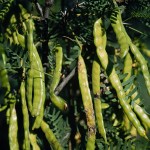Mesquite
Prosopis glandulosa
Fabaceae (Legume family)
Description
Mesquite is a small to medium height tree or shrub, thorny and single stemmed or branching near the ground. The leaves are deciduous and located alternately along the stems. The fruits are loosely clustered pods (beans) up to 8 or 10 inches long and may be abnormally abundant in drought years.
Habitat
Generally found throughout Texas, mesquite is common on dry ranges and in washes and draws at low elevations in the Trans- Pecos region. It is found from California to Texas, Kansas and Mexico.
Toxic Agent
Mesquite beans primarily affect cattle, although goats have also been affected. Sheep are reportedly resistant. Horses that eat the beans may be susceptible to impaction colic. In some ways, the syndrome produced by a diet of mesquite beans is best considered a nutritional problem. Mesquite beans have a high sugar content that, together with inadequacy in other dietary factors, alters rumen microflora, inhibits cellulose digestion and contributes to rumen stasis and impaction. B-vitamin synthesis is inhibited. Ketosis and starvation follow in severe cases.
Signs of Livestock Ingestion
The signs of the disease - jaw and tongue trouble - develop gradually, usually after cattle have been eating beans for 2 or more months. Animals may lose 50 percent of their weight. Afflicted cattle may salivate, chew continuously, sometimes with nothing in their mouths, and hold their heads to one side as if chewing is painful. About 25 percent of affected animals have a partial paralysis of the tongue, which protrudes 1 to 4 inches from the mouth. At least 10 percent of poisoned animals have swelling under their jaws or tongue, and some have noticeably enlarged salivary glands. Signs may include: Loss of appetite; Rapid weight loss; Nervousness; A wild expression; Bulging eyes; Death.
Horses with impaction colic will stand in a humped position and may kick at their abdomens.
Management Strategies
Most cases of poisoning occur in pastures where many mesquite beans accumulate, such as where pack rats store them. Prevent cattle from consuming beans as 60 percent of the diet for more than 60 days without adequate highquality roughage. If the disease has not progressed too far, three of four animals survive if given high-quality ground feed and rumen inoculation with fresh rumen fluid from an unaffected animal. Stocking cattle and sheep together can reduce cattle losses, because the beans apparently do not affect sheep. There are many specific chemical control recommendations for mesquite. For herbicides and rates, see Extension publication B-1466, Chemical Weed and Brush Control Suggestions for Rangeland.
Images
Plant Characteristics
Flower Color: Yellow
Seed Type: Bean/Pod
Duration: Perennial
Stem Texture: Prickly, Spiny, or Thorny
Growth Habit: Shrub (Woody)
Leaf Shape
 : Pinnately Compound
: Pinnately Compound
Season: Warm
Book: Toxic Plants of Texas (B-6105)
Collection: Toxics
Livestock Affected: Cattle, Goats, Horses
Livestock Signs: Abdominal Pain, Anorexia, Colic, Excess Salivation, Excitability, Trembling






